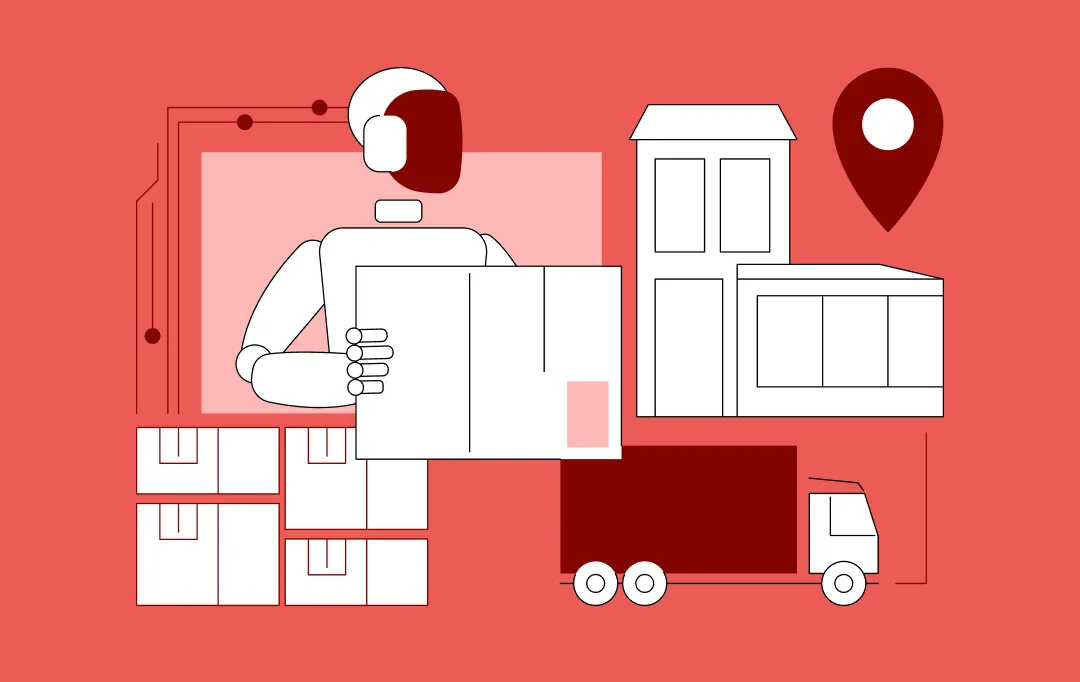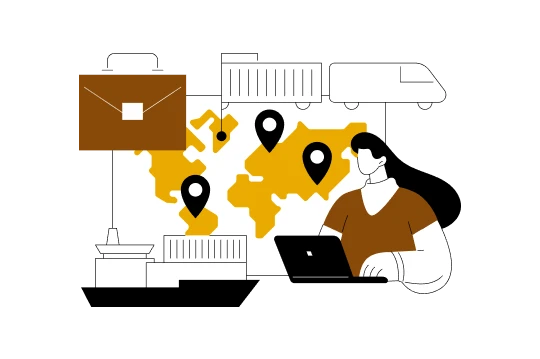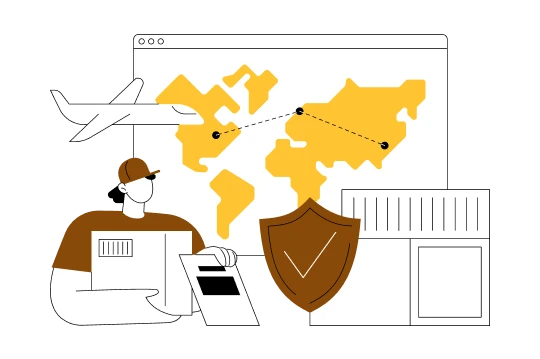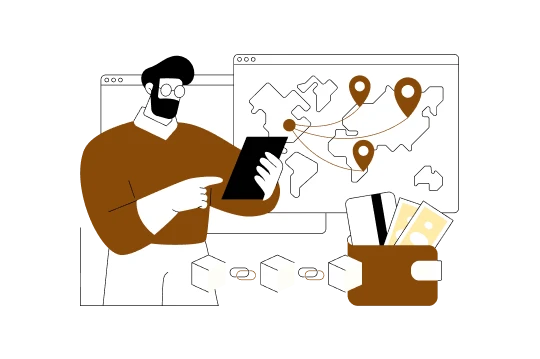- Why Modern Dubai Businesses Rely on Logistics Software
- Tailored Operations
- Scalable Enterprise Solutions
- Full Supply Chain Comprehension
- Robotization of Monotonous Processes
- Effective Transportation Control
- Better Supply Chain Visibility
- A Comprehensive View of the Costs Involved in Developing a Logistics App in Dubai
- Cost Breakdown by Complexity Levels
- How Development Costs Break Down Across Stages
- Estimating the Overall Costs
- Time and Effort Estimates
- Factors Affecting Logistics Software Development Costs in Dubai
- Complexity of Design
- Backend Development
- Third-Party Integrations
- Security Measures
- Compliance Measures
- Platform Selection
- Technologies Used
- Complexity of Features
- Hidden Costs in Logistics Software Development in Dubai
- Software Maintenance
- Hosting and Infrastructure
- Promotion and Implementation Support
- Legal, Licensing, and Compliance Costs
- Smart Ways to Control Logistics Software Development Costs in Dubai, UAE
- Start with an MVP
- Prioritize Only the Necessary Features
- Use Cross-Platform Development
- How to Develop Logistics Software in Dubai, UAE
- Requirements and Market Research
- Planning and Strategy Development
- Design and Prototyping
- Core Development
- Testing and Quality Assurance
- Deployment and Integration
- Post-Launch Maintenance and Optimization
- How to Build Logistics Software That Outperforms Competitors in the UAE
- Work on UI/UX Design
- Add Advanced Features
- Implement Next-Gen Technologies
- How Logistics Software Companies Make Money in Dubai, UAE
- Launch Your Next Logistics Software Project in Dubai with Appinventiv
- FAQs
Key takeaways:
- The cost of logistics software development in Dubai is usually between AED 110,000 and AED 300,000 and above, depending on complexity, features, and integration needs.
- The scope of features, integration with third parties, adherence to the regulations of the UAE, and the experience of the development team can be regarded as major cost drivers.
- The cost of maintenance, cloud hosting, and compliance with the law can inflate the development cost by 15-20% per year.
- Beginning with an MVP, focusing on basic features, and cross-platform development is a smart approach to optimize the overall cost and accelerate the development process further.
The logistics industry in Dubai is a cornerstone of the UAE economy, supported by strategic initiatives such as the Dubai Logistics Corridor and the Jebel Ali Free Zone. Such developments highlight the country’s desire to strengthen its status as a trading centre in the world. The logistics software is now indispensable in this dynamic environment, thus facilitating operations, route optimization, and real-time tracking.
Furthermore, the market of UAE logistics automation is projected to be $718.4 million in 2030 due to a number of factors (Source: GVR). This includes the rapid development of eCommerce, the rising need to see visibility and track their goods in real-time, the introduction of AI and IoT, and the necessity to make the supply chain process faster and more efficient.
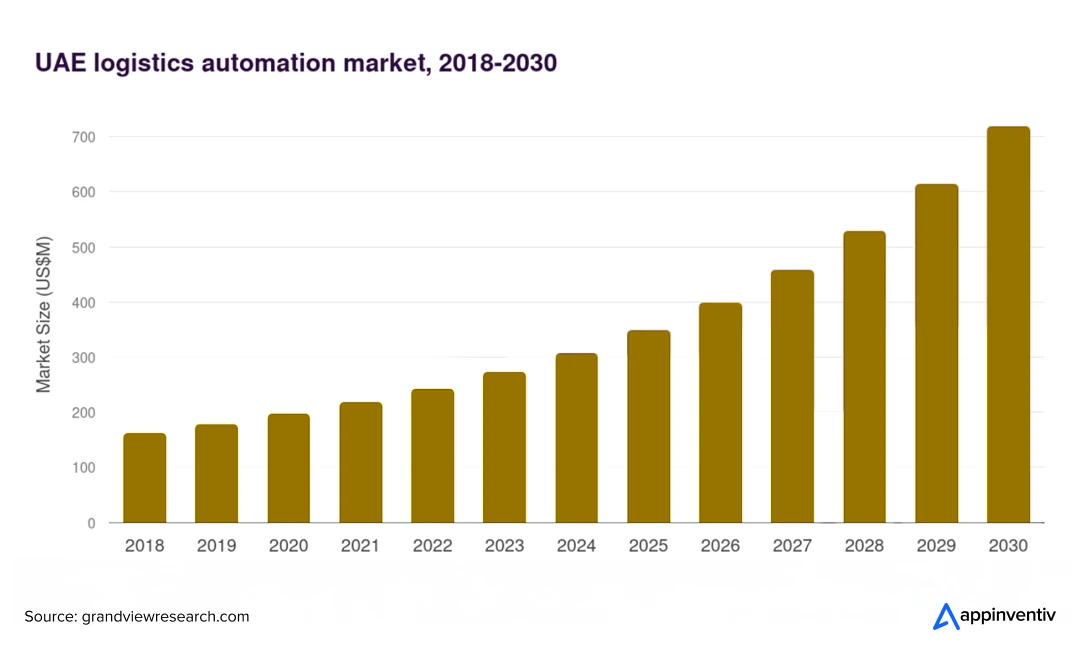
This underscores the increased need to have smart logistics solutions that increase efficiency, visibility, and sustainable growth in the UAE market.
If you’re into the logistics business and looking forward to upgrading your existing software or building one from scratch, then you must be wondering about the overall cost. This brings you to the right place, then, as we’ve covered all the cost-related intricacies of developing a robust logistics software tailored for the region’s unique operational and market requirements.
The logistics software development costs vary significantly depending on the complexity and functionality in Dubai. To have a simple logistic management system, the cost will be between AED 110,000 and AED 150,000 ($30,000 – $41,000). Middle-level products that have high features can be between AED 151,000 and AED 220,000 ($41,000 – $60,000). Enterprise-grade and high-end can be between AED 221,000 and AED 300,000 ($60,000 – $82,000). The cost drivers of these factors are the scope of features, integration requirements, and expertise of the development team.
Investing in custom logistics software is a prudent step for companies seeking to enhance efficiency and scalability. The main point is that cost knowledge is vital in making informed decisions and implementing them successfully.
Let’s dive deeper into the blog to explore a complete breakdown, including hidden cost factors, smart strategies to control expenses, steps to develop logistics software, and potential revenue models.
Turn your ideas into powerful digital solutions that drive measurable growth
Why Modern Dubai Businesses Rely on Logistics Software
For businesses in Dubai, logistics software has become an essential tool for managing operations efficiently. It helps streamline workflows, enhance visibility, and support scalable growth, ensuring companies remain competitive in a fast-paced market. Let’s have a detailed look at the key benefits of logistics software development in Dubai.
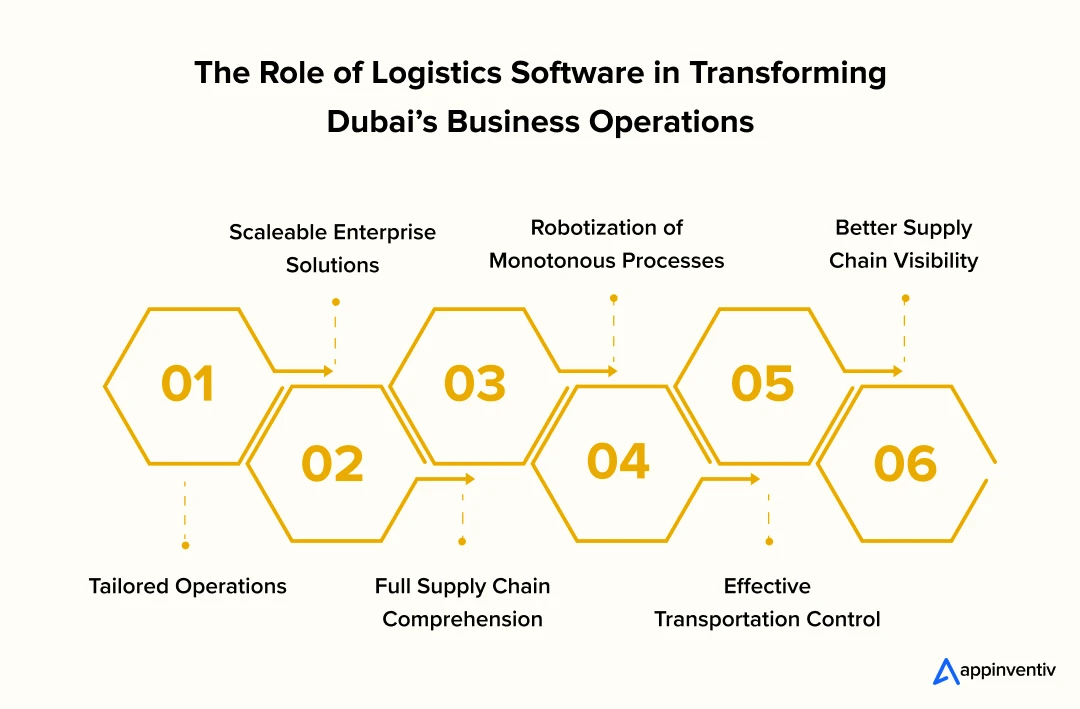
Tailored Operations
Custom logistics software development provides companies with the opportunity to create programs that are effectively applicable to their needs and processes. Companies can have more control over their processes, whether it involves managing complex inventories or tracking shipments in real-time.
Individualized software minimizes the number of human mistakes, simplifies intra-departmental communication, and aligns with individual business operations, which ultimately improves the reliability of services and customer satisfaction.
Scalable Enterprise Solutions
Enterprise logistics software development facilitates the operation of large-scale operations in multiple warehouses, fleets, and distribution networks. It offers an integrated platform of data integration and real-time reporting, and centralized monitoring.
This scalability enables businesses to grow easily, meet the increasing demand, and make strategic decisions supported by precise operational knowledge.
Full Supply Chain Comprehension
End-to-end logistics software solutions provide complete visibility throughout the supply chain, from procurement to final delivery. The combination of all operational phases makes the businesses reduce delays, plan the collaboration with suppliers and partners more efficiently, and track the performance throughout.
This holistic approach will make sure that the resources are mobilized in an efficient way, this increases efficiency and eliminates bottlenecks in operations.
Robotization of Monotonous Processes
The development of logistics automation software is based on AI, machine learning, and IoT, which can be used to automate repetitive processes such as shipment tracking and delivery scheduling, as well as report generation. This not only lowers the cost of operation but also gives the employees room to concentrate on strategic planning, innovation, and improvement of customer service.
Effective Transportation Control
Logistics software that is developed achieves optimization of fleet management, route planning, and real-time delivery tracking. Fuel and maintenance expenses are reduced by companies, delays are avoided, and the stability of transportation is enhanced. This is especially useful in Dubai, where time efficiency is crucial in a fast-paced logistics market.
Better Supply Chain Visibility
The development of supply chain and logistics software provides end-to-end visibility of inventories, shipments, and performance among suppliers. This openness would assist companies in locating bottlenecks, reducing risks, and enhancing partnerships with stakeholders. Having clear visibility is also advantageous for forecasting and efficient resource allocation.
Also Read: How Technology in Supply Chain can Surpass Challenges
A Comprehensive View of the Costs Involved in Developing a Logistics App in Dubai
When you’re developing a logistics app in Dubai, a bunch of factors affect what you’ll end up paying. With a competitive tech market and adherence to regulatory compliance, there are several other factors involved. Knowing what drives these costs makes it easier to plan your budget and avoid surprises later on. Let’s have a look at those.
Cost Breakdown by Complexity Levels
When you’re trying to pin down logistics software development cost in Dubai, it really comes down to what you’re building. Feature complexity, system integrations, and future scalability all play a significant role in determining the final investment.
| Complexity Level | Estimated Cost (AED) | Estimated Cost (USD) |
|---|---|---|
| Basic Apps | 110,000 – 110,000 | $30,000 – $30,000 |
| Mid-Level Apps | 147,000 – 220,000 | $40,000 – $60,000 |
| Enterprise Apps | 220,000 – 300,000+ | $60,000 – $300,000+ |
How Development Costs Break Down Across Stages
Building logistics software in Dubai isn’t a one-size-fits-all investment. Your total spend largely depends on how the budget is allocated throughout each phase, from early planning work to post-launch support. What you end up paying varies quite a bit based on how intricate your needs are, what you’re hoping to accomplish, and how big your logistics operation is.
Planning (10–15%)
This is the foundation work. We’re talking requirement analysis, feasibility checks, and getting crystal clear on what the software actually needs to do. It includes digging into market research, understanding who’ll use the system day-to-day, and making sure we’re compliant with UAE logistics regulations. We’re also sizing up resources, picking the right tech stack, and sketching out a realistic timeline.
You’re looking at roughly AED 30,000 to 45,000 (around $8,000–$12,000)
Design (15–20%)
This is where the application begins to take form. The structure and visual design come together through UI/UX layouts, wireframes, and clickable prototypes that illustrate how the app will function. The aim? An interface that feels intuitive and actually works well under pressure. For logistics companies here in Dubai, we typically prioritize multilingual capabilities (Arabic and English), clean dashboards that don’t bury information, and data visualization that makes sense quickly.
Budget typically falls between AED 45,000 and AED 60,000 ($12,000–$16,000)
3. Development (40–50%)
Development means actually writing all the code: the backend logic, the frontend interface, the necessary APIs, and then wiring up all the different systems, including GPS tracking, payment processing, and those smart, AI-powered analytics tools. It’s during this stage that you implement the core features, including determining the best delivery routes, offering real-time shipment tracking, and developing the warehouse management system.
When you’re building serious, on-demand logistics software for a big company, the key focus is making sure it can handle massive volume (scalability), automating as much as possible, and, of course, locking down the data security. You need that consistent performance, especially when demand suddenly spikes.
Estimated Cost: AED 120,000 – AED 150,000 ($33,000 – $40,000)
4. Launch (5–10%)
The app is now tested and ready to go. The launch phase is straightforward: getting the server set up, deploying the app to the App Stores and Google stores (or whatever internal enterprise systems are needed), and configuring everything for the live environment.
Sometimes, this stage encompasses marketing preparation, onboarding users, and running final system checks to ensure everything is in order. Since the logistics industry in Dubai operates at a rapid pace, mastering this process ensures the platform functions effectively from the very first day.
Estimated Cost: AED 15,000 – AED 30,000 ($4,000 – $8,000)
5. Maintenance & Updates (10–15%)
After everything is running, you move into ongoing maintenance. This is what keeps the system safe, running fast, and up-to-date. This covers things like fixing bugs that pop up, constantly monitoring performance, applying security patches, and enhancing existing features. Look, continuous improvement is absolutely vital in the UAE logistics market. Why? Because the rules (compliance), the tech, and what customers expect are changing all the time.
Estimated Cost: AED 30,000 – AED 45,000 ($8,000 – $12,000)
Estimating the Overall Costs
There’s a simple way to rough out a budget. Here’s the basic formula we use to get a handle on the total expense:
Total Cost = (Developer’s Hourly Rate × Hours of Development) + Costs for Wiring Up External Systems + Design Fees + Ongoing Maintenance Fees
This calculation provides businesses operating in Dubai with a realistic starting point for their investment, using typical local development rates as the foundation.
Time and Effort Estimates
- Simple Apps: Plan for about 3 to 4 months.
- Medium-Complexity Apps: You can expect a development time of 5 to 7 months.
- Large-Scale Enterprise Apps: These can take anywhere from 8 to 12 months, sometimes even longer.
The actual time needed always changes based on a few key things: how complicated the features are, how many different systems we have to connect them to (integrations), the time spent on necessary compliance checks, and the testing cycles. All those checks are super important, especially in Dubai’s carefully regulated logistics sector.
Appinventiv’s Insights
Any time you are making your timeline, it is prudent to add buffer time specifically to deal with unpredictable regulatory changes or integration challenges. The logistics industry in Dubai is very dynamic on the compliance standards front, where a third-party system might change API or workflows with little notice. These uncertainties should be factored in early so that your project remains on schedule, firefighting at the last minute is minimized, and you do not have to do expensive rework afterwards.
Factors Affecting Logistics Software Development Costs in Dubai
Logistics software development costs in Dubai can vary widely depending on the scope, features, and technology used. Businesses should plan their budget carefully to ensure a scalable, efficient, and future-ready solution that meets operational needs and market demands. Here are some of the crucial factors that affect logistics software development cost in the UAE.
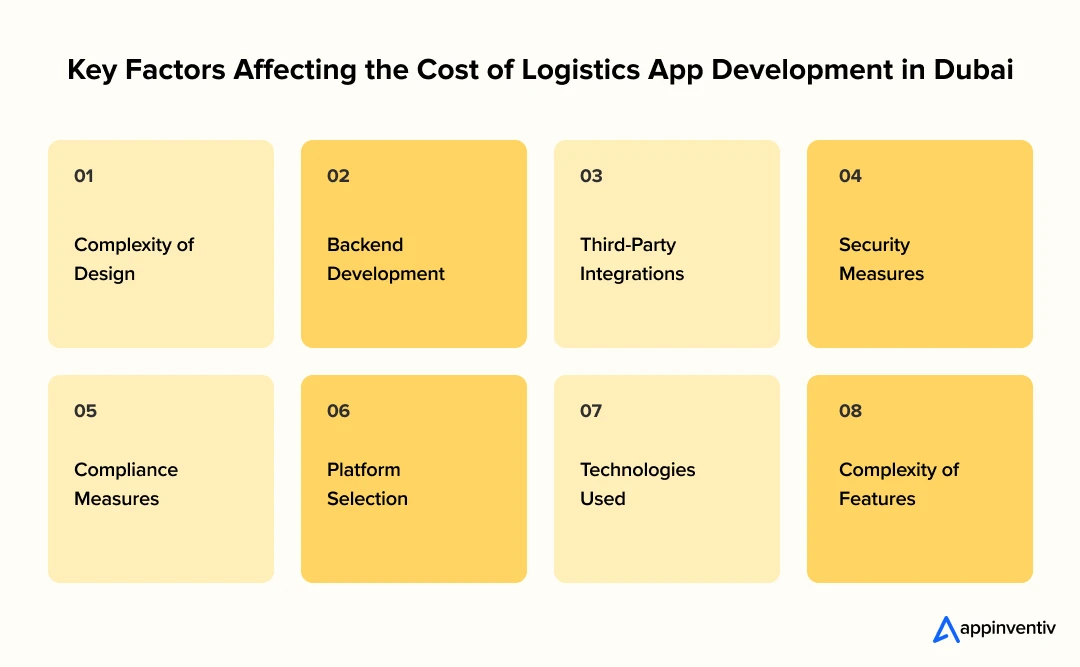
Complexity of Design
Logistics software design is not merely aesthetic, but it defines usability, efficiency, and the general user experience. The sophisticated interface containing interactive dashboards, real-time maps, notifications, and easy workflows requires additional time to be developed and tested.
There are also custom elements, animations, and multi-layered navigation, which make it more expensive. Proper software development ensures the quicker adoption of the software by employees and the greater accuracy of the work, which justifies the initial investment.
Backend Development
The backend is the support of logistics software, which deals with data storage, processing, and real-time activity. Scalable systems require advanced backend architecture such as multiple servers, databases, and APIs.
The automated tracking, dynamic reporting, and integration with internal enterprise systems are features that add to the development effort. Enterprise logistics software development usually involves dedicated backend structures to be reliable, fast, and have a smooth data flow between departments.
Third-Party Integrations
External system integration is more functional and complex. In modern logistics software, one can find payment gateway integrations, GPS tracking, IoT devices, and social media APIs. Every integration would need to be customized, security checked, and fully tested to make sure that it can be compatible.
Such integrations add more hours and costs to the development but enable companies to utilize the available tools to maximize efficiency, automation, and customer interactions.
Security Measures
The application of high-level security is necessary to secure sensitive business information and data. Such features as encryption, two-factor authentication, secure cloud storage, and user access controls contribute to the complexity of development.
High security measures implemented in the process of logistics management software development will raise the initial costs and losses associated with breaches, which will be avoided, ensuring compliance with the regulations and client loyalty.
Compliance Measures
The software should be in accordance with the local laws, such as the transport and trade law of the UAE, data protection policies, and customs. Compliance is typically associated with legal consultations, audits, and software testing to a great extent, ensuring that the software adheres to national and international standards.
Such requirements may lead to penalties or halt of operations, and therefore it is important that resources are spent on compliance when developing a project.
Platform Selection
The platform selected, whether it is web, mobile, or cross, will make a direct difference in cost. Native applications are necessary to support iOS and Android, whereas web applications can be developed with the help of responsive design and server optimization.
Cross-platform solutions are time-saving, yet they require frameworks such as Flutter or React Native. The platforms define the testing needs, the intricacy of maintenance, and the entire investment.
Technologies Used
AI-based logistics software development, along with implementing other advanced technologies like machine learning, IoT, predictive analytics, and cloud computing, will drastically raise expenses. The features allow smarter decision-making, predictive maintenance, and automated processes.
These technologies are frequently used to enhance efficiency, minimize delays, and deliver actionable insights in supply chain and logistics software development, justifying the greater development cost.
Complexity of Features
The cost and time of development depend on the number and complexity of features. Optimization of routes, real-time tracking of shipments, inventory prediction, automated reporting, and multi-user dashboards are some of the features that introduce complexities.
Custom logistics software development that has features of an advanced level involves a lot of coding, testing, and optimization to have a solution that would address the operational needs and will be capable of scaling as the business expands.
Request a personalized cost estimate and start planning your project today
Hidden Costs in Logistics Software Development in Dubai
Several hidden factors can significantly increase the total logistics software development cost in Dubai. These extra expenses usually pop up after you’ve deployed the system, yet they’re absolutely essential. You need to budget for them if you want your software to stay reliable, scalable, and fully compliant with the UAE’s operational standards.
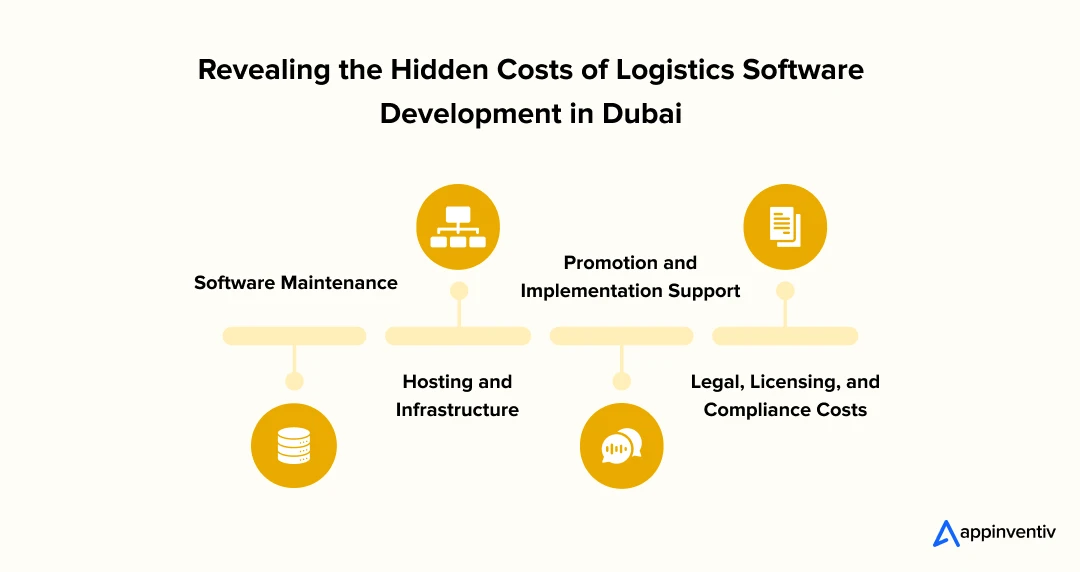
Software Maintenance
Once the system is live (after deployment), you need regular updates, security patches, and system optimizations. This is vital to keep those logistics systems stable and running at peak performance. For custom logistics software development, good maintenance is what makes sure you can smoothly integrate new business requirements and technologies as time goes on. Plan on spending about 15–20% of the total project cost annually on maintenance. The final number will swing depending on the system’s overall size and complexity.
Hosting and Infrastructure
Running a logistics platform requires substantial server capacity. Why? Because you’re managing real-time tracking, handling tons of shipment data, and running analytics. Cloud hosting is super popular in Dubai because it offers flexibility and helps meet local data laws.
For any medium to large enterprise logistics software development projects, expect hosting costs to be around AED 1,000 to AED 6,000 ($300–$1,600) per month. This depends on the bandwidth, storage, and the level of uptime required.
Promotion and Implementation Support
It doesn’t end with development. Companies often need to invest in user training, onboarding, and internal promotion to ensure the software is adopted smoothly. For logistics service providers, this frequently includes integrating with existing ERP systems or training staff on new digital workflows.
Businesses rolling out full end-to-end logistics software solutions also need to set aside money for marketing and getting the operations ready. Budget somewhere between AED 20,000 and AED 70,000 ($5,500–$19,000) for this.
Legal, Licensing, and Compliance Costs
Operating logistics software in Dubai means you must strictly stick to various trade, transport, and data protection regulations. You’ll need to pay for legal consultation and licensing fees, and these will shift depending on the sensitivity of the data and the scope of your operations.
These costs can easily start from AED 10,000 ($2,700) and definitely go up for any enterprise-grade solutions that deal with international shipments or financial transactions.
Smart Ways to Control Logistics Software Development Costs in Dubai, UAE
Building a logistics platform in Dubai is often a huge investment. However, careful planning actually helps businesses maintain a tight rein on expenses without sacrificing quality. The true logistics software development cost really comes down to how efficiently you structure and execute the whole project, right from the initial planning stage through to post-deployment support. Here are a few smart ways to manage spending while still making sure you get long-term performance and scalability.
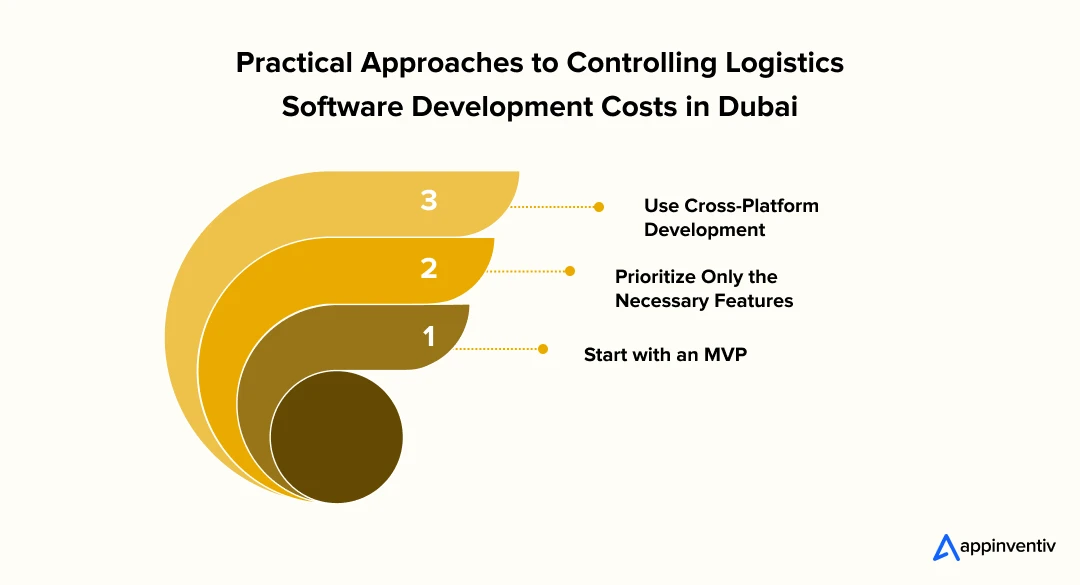
Start with an MVP
Launch a Minimum Viable Product (MVP) first. This lets you test the most essential features before you commit to the full, expensive development cycle. It’s critical for validating the concept in the unique Dubai logistics market.
You gather user feedback right away and make improvements based on actual data, not just guesses. By keeping the focus strictly on core functions, things like shipment tracking and route optimization, companies can manage budgets effectively while keeping future expansion clearly in view.
Prioritize Only the Necessary Features
Instead of building every feature you can think of all at once, figure out and develop just what aligns directly with your immediate business goals. This approach keeps the overall cost of logistic software development in Dubai, UAE, in check and speeds up deployment time.
If you’re running a logistics firm across the Emirates, prioritizing fleet management, order tracking, and core analytics tools creates a rock-solid foundation. You can always add the advanced capabilities later.
Use Cross-Platform Development
A great trick to optimize the overall cost is to use cross-platform frameworks. This lets your business roll out software across multiple devices and operating systems using just a single codebase. Not only does this accelerate development time, but it also significantly cuts down on maintenance expenses later.
For logistics companies based in Dubai, which manage both mobile fleets and complex warehouse systems, this method ensures consistent performance across all platforms at a significantly lower operational cost.
Appinventiv’s Insights
The idea of collaborating with local development teams or consultants familiar with the logistics situation in Dubai should be considered. Their experience concerning the regulations in the regions, their suppliers, and integration issues can prevent the expensive mistakes and make the development easier.
How to Develop Logistics Software in Dubai, UAE
Creating logistics software in Dubai isn’t a simple task; it’s a structured, multi-phase process. You have to nail the technical stuff while also meeting specific market compliance rules. Every step is vital, affecting the final quality, how much the system can grow (scalability), and the overall investment in the project.
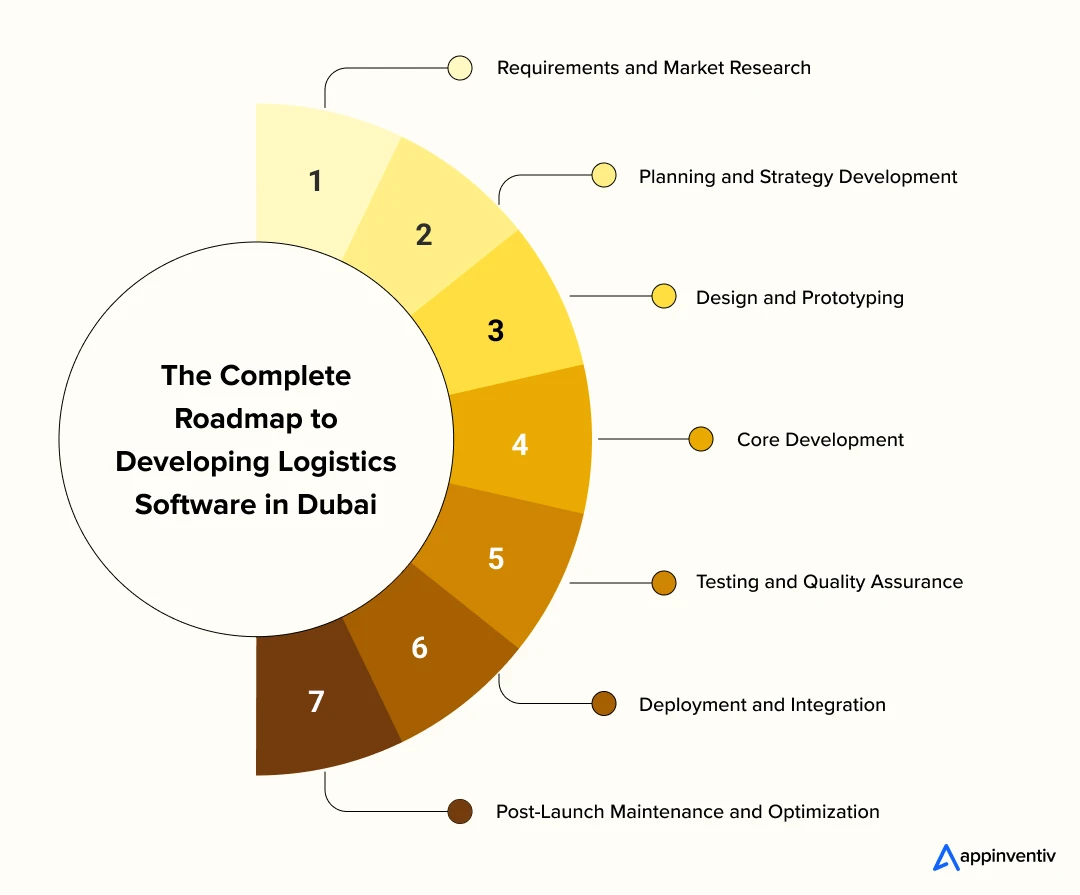
Requirements and Market Research
The whole process kicks off by defining your business objectives. Then, you need to figure out what users actually need and, importantly, assess your competition inside the UAE logistics sector. This initial step is what helps you align your product idea with local rules, regulations, and operational standards.
Planning and Strategy Development
Next up, you build a detailed project roadmap. This means locking down timelines, setting milestones, and figuring out where resources will go. This stage is also when you start to get a handle on the logistics software development cost, considering factors like the tech stack, the complexity of the features, and those scalability needs.
Design and Prototyping
This is where the look and feel come together. UI/UX designers create user flows, wireframes, and interface mockups, all to make sure the system is clear and easy to navigate. For logistics systems, the focus is heavy on dashboard usability, making sure real-time data is visible, and ensuring solid mobile responsiveness.
Core Development
The developers get busy writing the code for the frontend, backend, and all the necessary APIs. This stage often includes connecting other systems for fleet tracking, payment gateways, warehouse management, and route optimization. Using modular coding practices here is smart; it ensures you get flexibility for future updates.
Testing and Quality Assurance
Before anything goes live, you must run rigorous testing. This is how you catch bugs, confirm data accuracy, and verify system performance under pressure. Security and compliance testing are particularly crucial for any logistics software that operates within Dubai’s regulated trade environment.
Deployment and Integration
Once testing is totally complete, the software is deployed to your production servers or the chosen cloud platform. Integration with any existing enterprise systems (like your ERP or CRM platforms) is essential now. This step guarantees smooth operation across all your different business functions.
Post-Launch Maintenance and Optimization
After deployment, the work shifts to ongoing support. That means handling updates, fixing any bugs that pop up, and adding feature enhancements. Continuous monitoring ensures performance stays stable and the system retains its long-term scalability. These ongoing improvements are what help control the cost of logistic software development in Dubai, UAE, over time, keeping the system aligned with business growth.
How to Build Logistics Software That Outperforms Competitors in the UAE
Building logistics software that outperforms competitors in the UAE requires a focus on efficiency, reliability, and innovation. Let’s have a look at some of the key tips that you can follow in order to beat your competition.
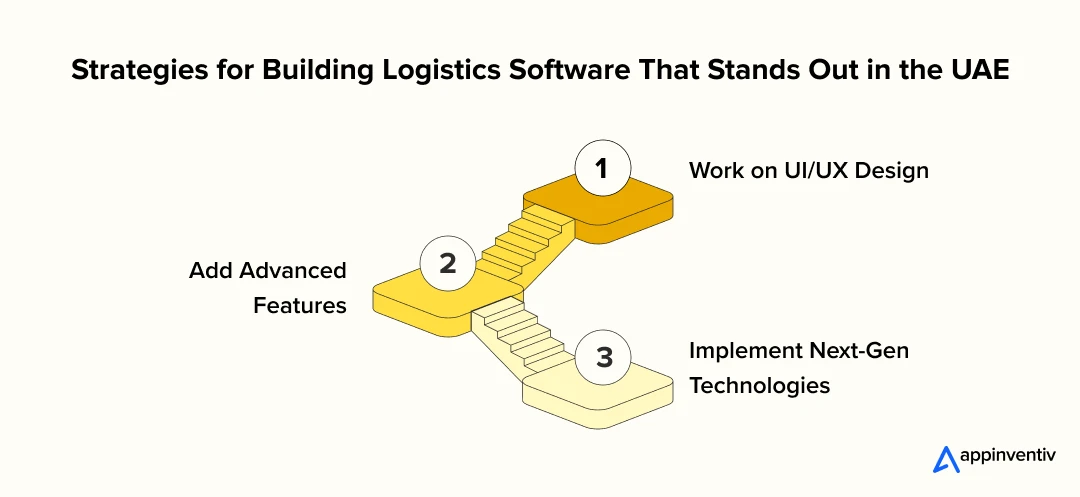
Work on UI/UX Design
The logistics software must have a good user interface and user experience. The platform is designed to be user-friendly due to its ability to integrate with the processes of drivers, warehouse employees, and dispatchers, as well as minimizing operational errors.
When data is clearly visualized, it becomes easier for teams to make decisions more quickly and accurately. Mobile optimization can ensure that users can access essential updates at any time and from any location, while personalization features can enhance overall usability.
Add Advanced Features
The comprehensive features are important in being on top of the UAE logistics market. End-to-end freight management combines the booking, tracking, and invoicing of freight in a single platform, removing redundant tools.
GPS and IoT can be tracked in real-time, providing complete control over cars and shipments. The optimization of routes by AI lowers expenses on fuel and delivery durations, and the automation of monotonous processes liberates teams to concentrate on strategy.
Implement Next-Gen Technologies
The efficiency and scalability of the software are enhanced by leveraging the right technologies. Predictive analytics and artificial intelligence enhance demand forecasting and contribute to predicting disruptions.
The IoT integration offers vehicles, equipment, and inventory real-time monitoring, whereas the cloud computing offers flexible and scalable access. It is integrated with the existing enterprise systems to facilitate smooth operations, and data analytics is used to make informed decisions to streamline the whole supply chain.
Let us help you build software that combines innovation, speed, and reliability to stay ahead of competitors
How Logistics Software Companies Make Money in Dubai, UAE
Logistics software providers in Dubai use a few different ways to charge, making sure they can serve businesses of all sizes and operational complexity. Here are some of the top monetization methods that guarantee predictable revenue for the providers and still offer flexible, cost-effective options for their clients.
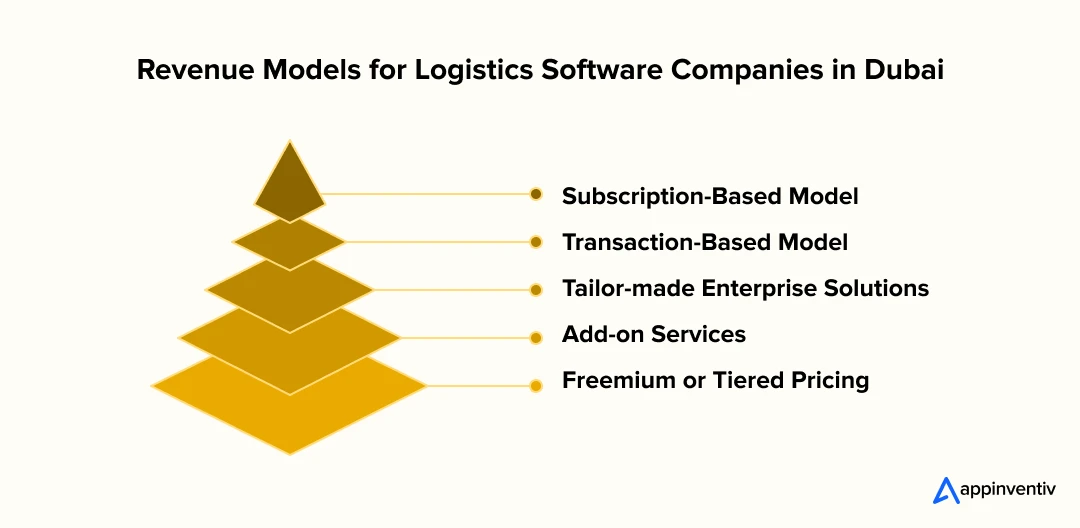
Subscription-Based Model: Companies receive monthly or annual subscriptions to access updates and assisted services, and are guaranteed a steady stream of income.
Transaction-Based Model: It charges on a per shipment, order, or delivery basis, which matches the costs with usage.
Tailor-made Enterprise Solutions: Bigger operators are charged to license, implement, and integrate with high-priced support for complicated business.
Add-on Services: Add-on services also generate revenue, including analytics dashboards, AI-driven route optimization, and real-time tracking.
Freemium or Tiered Pricing: This model allows a small company to begin with basic functionality and expand to higher levels of functionality as it grows.
Launch Your Next Logistics Software Project in Dubai with Appinventiv
The future of logistics in Dubai is poised for rapid transformation; it’s set to explode. We’re talking beyond just AI and data-driven operations. Think robotics, autonomous vehicles, drone deliveries, IoT-enabled smart warehouses, and blockchain-powered supply chains. Businesses here should expect predictive analytics, highly advanced fleet management systems, and sharp real-time tracking solutions. These aren’t minor updates; they’re going to completely redefine efficiency, reliability, and competitiveness in this market.
As a leading custom software development company in Dubai, Appinventiv empowers logistics companies to embrace these innovations. We’ve helped a ton of clients, we seriously streamlined their operations, truly optimized supply chains, and achieved specific, measurable results. Whether it’s intelligent route optimization or building a fully integrated digital platform from the ground up, we build solutions that are always tailored to each client’s unique needs. We just make their operations future-ready.
For instance, we assisted a global manufacturer in building a single, unified logistics dashboard that connected all the regional systems, giving real-time information on inventory, shipments, and deliveries.
The forecasting module was also introduced, which allowed the operations department to better plan and react to changes in demand faster, thereby improving the supply chain visibility by 60%. This solution simplified the coordination system, reduced the number of missed shipments, and maximized the utilization of routes in the international network.
Don’t just take our word for it. Go check out our client testimonials. See exactly how we’ve transformed logistics operations across various industries. Our dedication to excellence hasn’t just been local; it’s been recognized globally. We’ve earned serious recognition, like the Deloitte Technology Fast 50 India and being named a Leader in AI Product Engineering & Digital Transformation by The Economic Times.
Partner with our experts today and let us help you turn those complex logistics problems into tangible, strategic advantages. It doesn’t matter if you just want to upgrade your existing systems or need to build a completely new platform. We have the necessary end-to-end expertise to bring your vision to life.
FAQs
Q. What are the challenges in logistics software development?
A. The on-demand logistics software development is associated with several challenges. This includes:
- Complexity of integration: The seamless response between ERP, CRM, and IoT.
- Real-Time Tracking: The company should ensure that shipment and inventory updates are accurate and up-to-date at all times.
- AI & Route Optimization: The adoption of sophisticated algorithms to achieve efficient operations.
- Scalability: Ability to accommodate large shipments without a performance problem.
- Security and compliance: Data privacy and compliance within the UAE.
Q. What is the estimated cost of developing an MVP for logistics software in Dubai?
A. An average logistics software MVP will cost between AED 110,000 and AED 300,000 ($30,000 to $300,000) to develop in Dubai, UAE. Simple MVPs consist of such basic features as shipment tracking, inventory management, and dashboards.
Enhanced MVPs that are AI-based and include route optimization, multi-modal support, and real-time notifications can make the budget go up. There are also third-party integrations, design, and testing, which affect the final cost.
Q. Do UAE compliance regulations and VAT affect logistics software development costs?
A. Yes, UAE compliance and VAT affect the cost of logistics software. To comply with government regulations, developers should incorporate tax-compliant invoicing, accurate VAT computation, and reporting modules. The complexity and time required for developing these features are justified to ensure the platform is legally and operationally sound.
Q. Which technology stack is typically used for logistics software development?
A. An example of a common logistics software technology stack in Dubai would consist of:
- Frontend: React, Angular, Vue.js, Flutter/React Native (mobile apps).
- Backend: Node.js, .NET, Python, Java.
- Database: MongoDB, MySQL, PostgreSQL.
- Cloud: Hosting AWS, Azure, GCP.
- Other Tools: GPS/IoT Accommodation, AI/ML architectures, ERP, and payment APIs.
Q. What are the annual maintenance and support costs for logistics software in Dubai?
A. Maintenance and support of Dubai-based logistics software. Typically, maintenance and support range from 15 to 20% of the original development cost. It includes software revisions, correction of bugs, optimization, compliance changes, server maintenance, and support, which will ensure that the system is secure, efficient, and in line with UAE regulations.


- In just 2 mins you will get a response
- Your idea is 100% protected by our Non Disclosure Agreement.
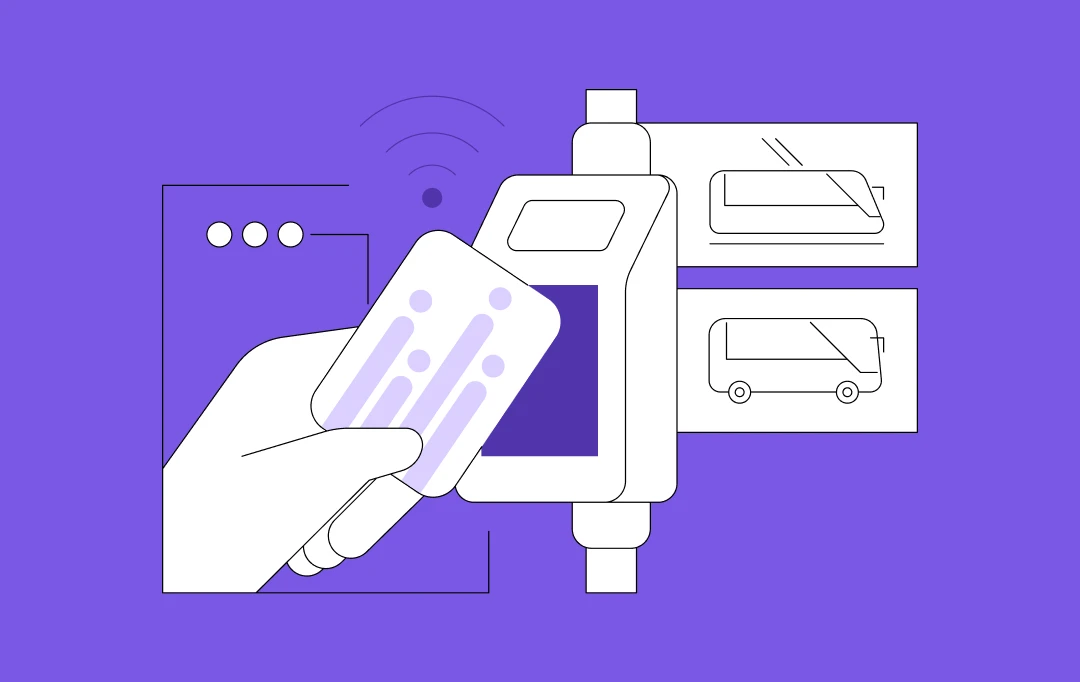
How to Build an RFID Asset Tracking System in The UAE?
Key takeaways: The success of an RFID asset tracking system is dictated by the quality of the custom software and middleware, which must transform voluminous raw tag data into actionable intelligence. Implementation of RFID systems requires a managed, multi-stage process, moving logically from Integration Consulting and architectural design to Continuous Monitoring and Optimization, which is…
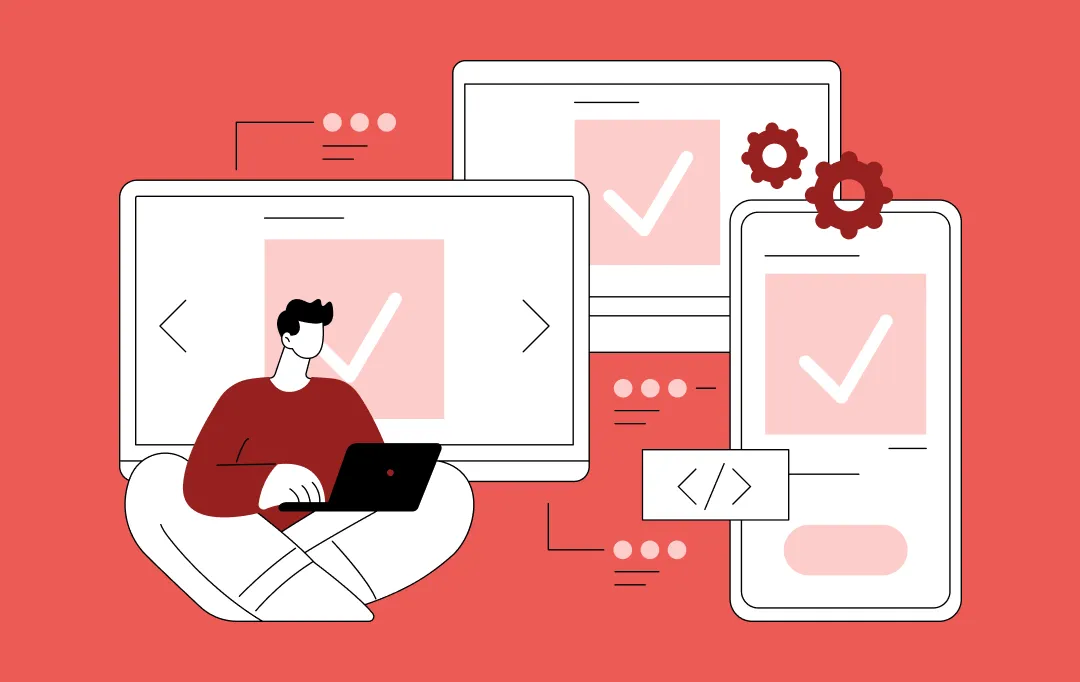
How to Build a White-Label Grievance Management Software? Process, features, costs
Key Takeaways White-label grievance management software allows businesses to quickly implement, rebrand, and scale solutions without reinventing the wheel. The development process involves multiple stages, including requirement gathering, workflow design, tech stack selection, and ensuring compliance and scalability. Key features include multi-channel intake, automated routing, customizable workflows, AI-driven categorization, and built-in compliance and security. Costs…

How to Build a Demand Forecasting Software?
Key Takeaways Modern demand forecasting software leverages AI and real-time data to boost accuracy and efficiency. Custom solutions integrate seamlessly with ERP, CRM, and inventory systems for end-to-end visibility. Accurate forecasting reduces costs, optimizes resources, and improves customer satisfaction. Cloud-based, scalable platforms make advanced demand planning accessible to businesses of any size. Demand forecasting used…













